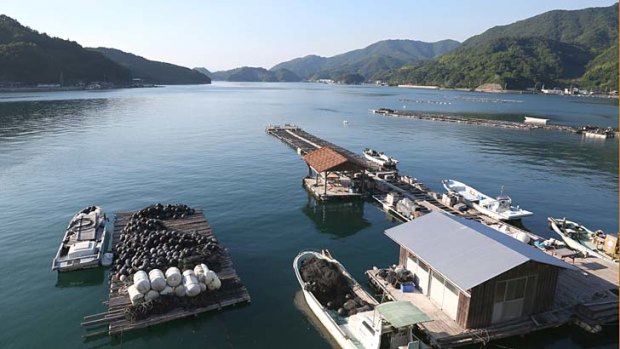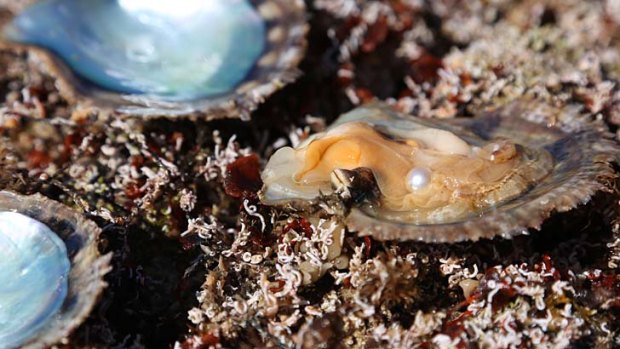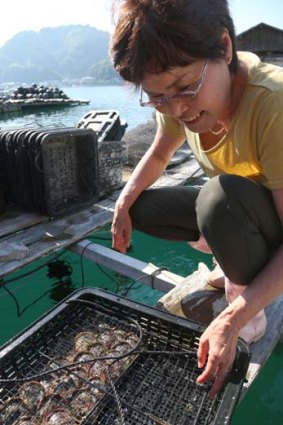By Jamie Lafferty

Small scale: The Doi Pearl Farm.
Oysters may now be given a helping hand to create pearls, but nature and luck still play a part.
A few years ago, before its streets were awash with violent anti-government protests, I went to Bahrain to learn about its pearl trade. For centuries, pearl diving had been the tiny island nation's main industry.
When the season was at its peak, every man on the island - 30,000 of them - would be involved in the often brutal process of diving for oysters, sinking into the depths with animal stomachs full of air their only oxygen supply. Many drowned. Others suffered from the bends. Some simply disappeared.

A freshly opened pearl at the Doi factory.
Despite these harsh conditions, Bahraini pearls were regarded as among the best in the world. Europe's fussiest jewellers, including Jacques Cartier, would travel to the Gulf to inspect their quality. Then, in the East, a technological breakthrough occurred. The Japanese learnt how to synthesise pearls.
Experts could not tell the difference between pearls that had been foraged from the bottom of the sea and those that had been manufactured. Within a year, the Bahrainis were put out of business, although fortunately, about the same time as the British discovered oil off their shore, saving the island's economy.
As I sit at the Doi Pearl Farm in Ehime prefecture on the island of Shikoku, Japan, I mention how unfair this seems. Pearling had been the heart and soul of Bahrain. It is even said that its red and white flag is based on a pearl sitting on a silk presentation sheet.

Oysters being retrieved from the water.
"Red? Are you sure?" asks Kazunori Doi, joint owner of the pearl farm in the Uwajima region of Ehime. He has always presented his pearls on white, so as to see their pure colour, untainted by their surroundings. He insists that to present them on red would give them a pinkish hue.
Before coming to Japan, I imagined that the Bahrainis had been usurped by a sterile, clinical procedure developed by the Japanese. At best, I expected to find laboratories or factories, mass-producing pearls by the millions. Instead, the process takes place on a small scale, with oysters being individually impregnated with plastic beads, before being placed into the water for anything up to two years.
Although the synthetic technique gives the pearls more of a fighting chance, Mother Nature and luck still play essential roles in their formation. Pearl farming in Japan is a surprisingly imprecise business. When Doi explains that the oyster undergoes a "small operation", I assume it to be a mistranslation, but there is no better way to describe the delicate surgery that takes place.
With the utmost care, the shell is opened, a small incision is made into the pocket membrane and a tiny white ball is placed inside. This is one of the biggest advantages of this synthetic method - the oyster will coat a perfectly spherical object, increasing the chances of a round pearl. In the wild, the oysters latch onto anything that makes its way into the shell, often irregular-shaped grains of sand.
The oysters can be submerged for as long as two years, although most come out after one. The longer they stay in the water, the greater the risk of failure, and the more they have to be cleaned. The shells are tended to every two weeks while underwater, with parasites and grime removed. This contradicts what I heard in Bahrain, where divers believed ugly shells provided better jewels.
The size of the pearl can be influenced by the size of its implant and the length of time it stays in the water, but the colour is randomly assigned by the oyster.
So efficient are the pearl surgeons that 600 of these implants can be made in a day, yet nowhere near that many survive. It's a bit like a mother turtle laying hundreds of eggs on a beach, then abandoning them to their fate. Half the oysters die from the operation. Of the survivors, 60 per cent are usable in some way, but only about 4 to 5 per cent are regarded as top quality.
Doi Pearl Farm offers guests the chance to pick an oyster and see what they find. If their first selection is dead, they can go again until they find a live one. If they like, they can eat the oyster too. It's hardly free-diving in the ocean, but fun nonetheless, especially since there is then an option to have the little treasure immediately made into a piece of jewellery.
Doi then offers me a crash course in pearl inspection. A master with decades of experience, he sees things my eyes do not. A good pearl must have a consistent colour and a perfect surface. Impurities render it almost worthless. When he tells me this, I look at my poor, warty little pearl with pity. It looked so beautiful when the shell was prized open, but now I notice an unsightly lump.
Bigger pearls can often be worth more, but not if they are a boring colour or disfigured in any way. If they have a naturally pink hue, they are worth a lot more. Find a series of perfect pink pearls and you can assemble a necklace worth thousands of dollars.
It may not have the romance of finding something at the bottom of the sea, but Doi does have a personal treasure - his uber-pearl, a fat, flawless beauty. He keeps his one-in-a-million pearl alone in a case and only occasionally brings it out to let guests see what perfection looks like. He refuses to put a value on it and is fairly sure he wouldn't sell it. To me it's just another pearl, but to the master, it clearly means a lot.
"Have you named it?" I ask when I see the adoring look on his face. "No, no, no," he says shaking his head, "That would be crazy."
The writer was a guest of the Shikoku Tourist Board (tourismshikoku.org). The Real Japan group (real-japan.com) organises tours of the island of Shikoku, including visits to the Doi Pearl Farm, and the wider Ehime prefecture. Prices vary with itineraries. Pearls are harvested year round at Doi.
Sign up for the Traveller Deals newsletter
Get exclusive travel deals delivered straight to your inbox. Sign up now.